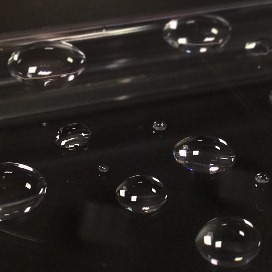 A collaboration including scientists from Diamond Light Source have helped to develop a new tool to investigate the liquid to glass transition – one of the lesser understood areas of condensed matter physics.
A collaboration including scientists from Diamond Light Source have helped to develop a new tool to investigate the liquid to glass transition – one of the lesser understood areas of condensed matter physics.
The work formed part of a collaboration between the Advanced Photon Source (APS), USA, Diamond Light Source, and the Hamburger Synchrotronstrahlungslabor ‘HASYLAB’, based at DESY, Germany.
Researchers from APS and Diamond came together nearly seven years ago with the goal of making a very high resolution X-ray spectrometer which would work on a medium-energy synchrotron such as Diamond, and suitable for free-electron laser sources.
In order to measure the very small changes in the energy of an X-ray as it bounces from a sample, a very high energy resolution – less than 1 millivolt, or a ten-millionth of the initial energy – is required.
Until now, this was beyond the capabilities of X-ray spectroscopy techniques, as the energy required was above what sources like Diamond could offer, and even these techniques could not provide such a good energy resolution.
“The only person who’s ever come up with any sort of viable alternative technique to this standard approach is Yuri Shvyd’ko (our collaborator at APS)” explains Professor Steve Collins, of Diamond Light Source.
“We’ve worked for nearly seven years, gradually developing concepts and helping build components at Diamond to test” continues Prof Collins. “A few months ago we put things together, in what was probably one of the most complex beamline setups I’ve ever seen, but things proved to work very well.”

Layout of the UHRIX instrument in the vertical (y,z) scattering plane showing all optical elements and all 15 deflections of the X-ray beam. Rotation of the analyser system in the horizontal plane (x,z) by an angle ϕy about the vertical y axis passing through the sample provides access to photons scattered with a momentum transfer Q=2k sin (ϕy /2). (Shvyd’ko et al, 2014)
The new spectrometer makes use of an atomic scale diffraction grating, analogous to a classical optical spectrometer setup, only rather more intricate. “The X-rays bounce about 15 times prior to reaching the detector” explains Prof Collins, “which has to be something of a record.”
By producing reliable data at 9 keV, this new spectrometer opens up the use of light sources such as Diamond and free-electron lasers to investigate the liquid-glass transition and other unresolved problems in the physical and life sciences.
Prof Collins: “This transition is really interesting to us, as we don’t really understand the difference between liquid and glass apart from the fact that one’s hard and the other isn’t!”
The whole spectrometer was tested at APS to study the dynamics of liquid glycerol, observing molecular dynamics at previously inaccessible length- and time-scales.
Diamond’s Test Beamline B16 was used to trial the spectrometer’s collimating optic, a component built at Diamond. This required a large amount of space, so the space and versatility B16 offered was key to the researchers.
As synchrotron radiation produced by Diamond Light Source is naturally highly collimated, the researchers actually tested the optic ‘backwards’ to see the radiation focussed down to a point. “If it works one way round – it should work the other way round” explains Professor Collins.
To find out more about using Test Beamline B16, or to discuss potential applications, please contact Principal Beamline Scientist Dr Kawal Sawhney: [email protected]
Shvyd’ko Y. et al. High-contrast sub-millivolt inelastic X-ray scattering for nano- and mesoscale science, Nat Comms 5 4219 (2014). DOI:10.1038/ncomms5219
Diamond Light Source is the UK's national synchrotron science facility, located at the Harwell Science and Innovation Campus in Oxfordshire.
Copyright © 2022 Diamond Light Source
Diamond Light Source Ltd
Diamond House
Harwell Science & Innovation Campus
Didcot
Oxfordshire
OX11 0DE
Diamond Light Source® and the Diamond logo are registered trademarks of Diamond Light Source Ltd
Registered in England and Wales at Diamond House, Harwell Science and Innovation Campus, Didcot, Oxfordshire, OX11 0DE, United Kingdom. Company number: 4375679. VAT number: 287 461 957. Economic Operators Registration and Identification (EORI) number: GB287461957003.